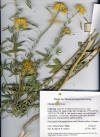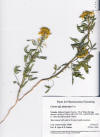|
Cleome lutea |
Cleome
aff platycarpa |
|
Cleome lutea |
Cleome serrulata |
|
Williams L. A., E. Vasques, W. Reid, R. Porter and W. Kraus W. 2003. Biological activities of an extract from Cleome viscosa L. (Capparaceae). Naturwissenschaften 90(10): 468–472. “Electron micrograph examination of the leaf and stem surfaces of Cleome viscosa L (Family Capparaceae) revealed the presence of secretory glandular trichomes with club-cylinder and cylinder morphologies. In the present study, the leaves and stems of C. viscosa were extracted with hexane and the extract was evaluated for the following biological activities: anti-bacterial, anti-fungal, contact insecticidal and nematicidal. The extract was found to be a potent anti-bacterial agent according to the thin layer chromatography autobiographic assay. Activity-directed isolation studies of the anti-bacterially active compounds led to a 14-member ring cembranoid diterpene being identified as one of the effective agents. Minimum inhibitory concentration (MIC) values (microg/spot) of 5.0 microg/spot and 1.0 microg/spot were found for the diterpene on Bacillus subtilis (Gram-positive) and Pseudomonas fluorescens (Gram-negative), respectively. The diterpene did not inhibit the growth of the fungus Cladosporium cucumerinum. The extract demonstrated a pyrethroid type of contact insecticidal activity on adult Cylas formicarius elegantulus Summer (Coleoptera: Curculionidae). The extract also had high nematicidal activity with a percentage Abbott's value of 72.69 on the plant parasitic nematode Meloidogyne incognita Chitwood; however, the extract lost its potency upon subfractionation.” |
|



